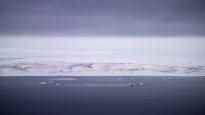The research professor does not believe that continental shelf requirements will increase conflict sensitivity in the Arctic Ocean: “The more likely danger scenario is a military confrontation started due to misunderstandings”
Canada wants an even bigger area of the Arctic seabed. Barents Observer (you switch to another service) reported before Christmas that Canada submitted an application to the International Commission on the Limits of the Continental Shelf, which would increase Canada’s rights in the Arctic region.
The same region has also been claimed by Russia, which already owns most of the Arctic region.
Research professor at the Arctic Center Timo Koivurovan according to the continental shelf requirements in themselves hardly increase conflict sensitivity in the Arctic region.
The expansion of economic zones has been simmering for a long time. The coastal states of the Arctic Ocean have completed their own applications one by one, as Canada is doing now. For example, Russia has sent a large number of different expeditions to the region to explore the Arctic to help determine their own territory.
One of the disputed areas is known as the Lomonosov Ridge, a type of undersea mountain range that runs across the sea floor of the Arctic Ocean. Canada, Russia and Denmark all consider the ridge to be part of their territories. The most famous point of the Lomonosov ridge is the north pole.
No immediate threat
Although the Arctic region has become accustomed to being considered a peaceful area, according to Koivurova, quiet legal processes have been going on there for years. Continental shelf requirements are also such silent, years-long processes, which, according to Koivurova, are good to distinguish from actual crisis babies.
A conflict in the Arctic region is unlikely right now, despite the tense atmosphere.
– Russian troops are now stuck in Ukraine, so there is no immediate threat, but the war in Ukraine made Arctic cooperation difficult.
Especially when one of Russia’s most important military centers is precisely on the Kola peninsula.
– After the war, we will see if a regime like Putin or a similar person is in charge, and if there is, then of course the Arctic region will be a difficult region in terms of security policy. Then probably all the Arctic states except Russia would be in NATO, which Russia considers an enemy organization.
Even before the war in Ukraine, Russia and NATO increased their military presence in the Barents and Norwegian seas.
On the other hand, the NATO membership of Finland and Sweden stabilizes the region.
– Military force can be shown to be a valid counterforce that raises the threshold for conflict in the Arctic region.
A clash arising from misunderstandings
According to Koivurova, a more likely danger scenario is a military confrontation started due to a misunderstanding.
– This is because, especially before the war in Ukraine, there was so much military equipment and presence in the Barents Sea/Norwegian Sea, which could have escalated into a conflict due to human error.
It is estimated that it will take several years to process maritime rights claims. After this, it is up to the states themselves to negotiate the borders based on the commission’s recommendations.
The UN Convention on the Law of the Sea (UNCLOS) secures an exclusive economic zone of 200 nautical miles for each of the coastal states of the Arctic Ocean, Russia, Norway, Canada, the United States and Denmark (Greenland). In its own economic zone, each country has the right to utilize the potential natural resources of its own territory, such as oil or gas reserves. One nautical mile is about two kilometers.
According to the same law, each country has the right to expand its own territory if the state has scientific evidence that the seabed in question is an extension of their own continental shelves.
